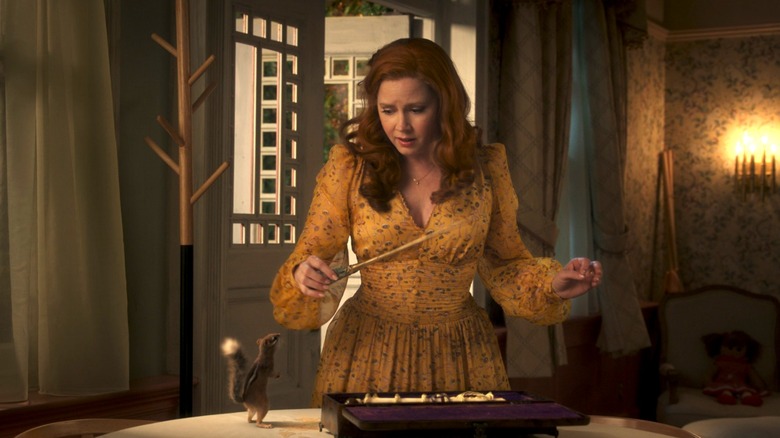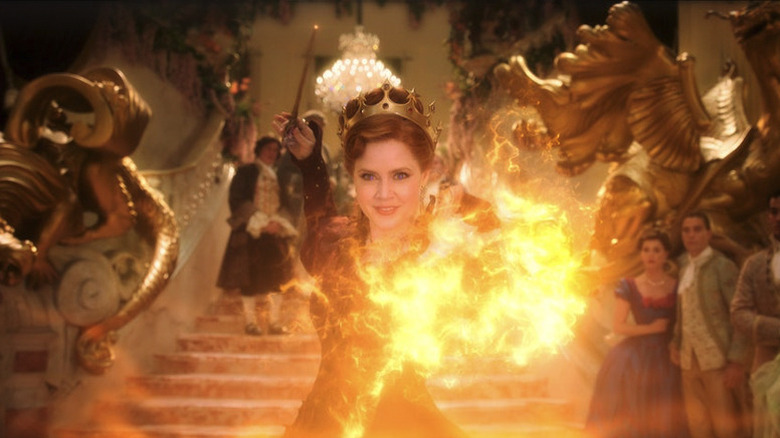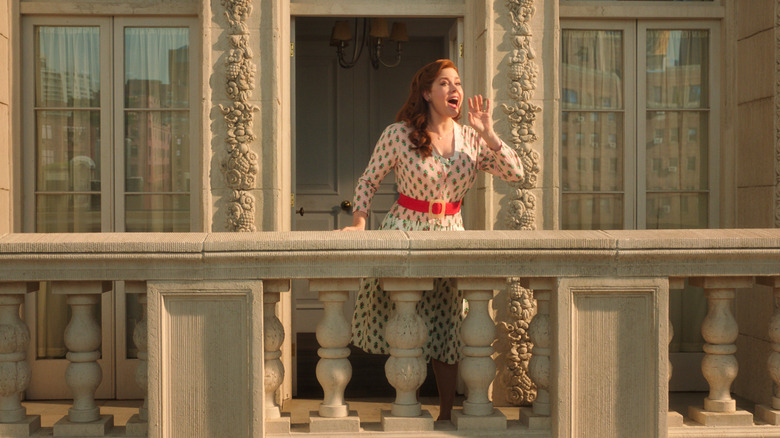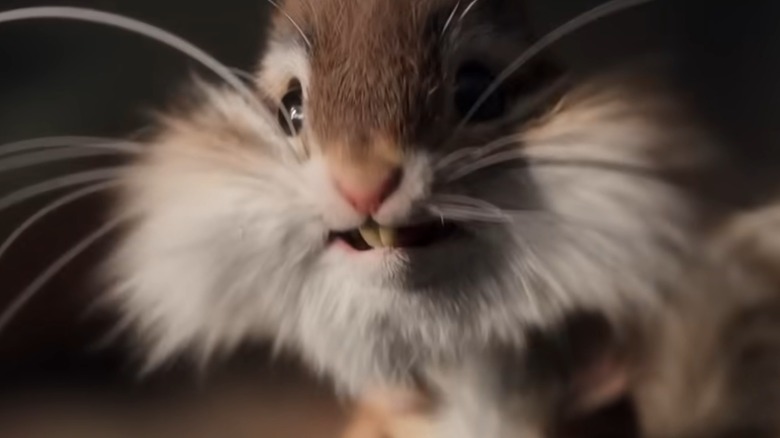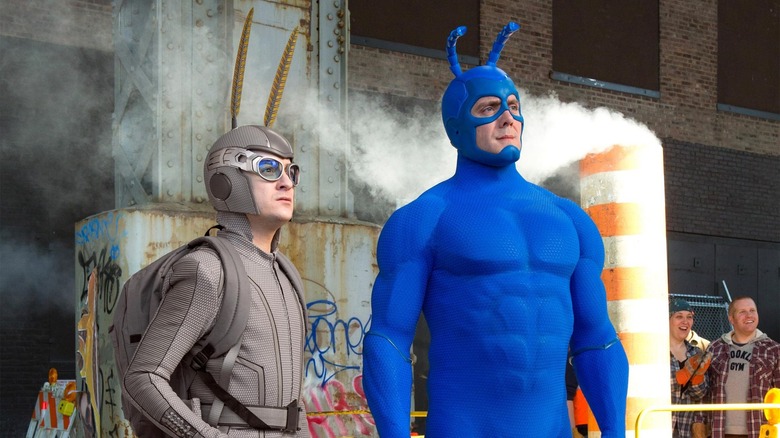Griffin Newman Won His Role In Disenchanted Thanks To A Zoom Table-Read [Exclusive Interview]
The new Disney+ film "Disenchanted" is a long time coming, following up the 2007 comedy that served as Amy Adams' breakout role. In "Disenchanted," Giselle, an animated princess who winds up in New York City, inadvertently brings fairytale characters, like her old friend Pip the chipmunk, to our world. This time around, Pip's a lot chattier, and is now voiced by Griffin Newman, comedian, co-host of the popular movie podcast "Blank Check with Griffin and David," and actor from "The Tick" and "Masters of the Universe: Revelation."
/Film sat down with Newman to talk about his unconventional casting, the possibility of becoming a Disney toy, fan encounters, and his recent Twitter suspension.
'You check all the boxes of everything you would ever dream of doing as a Disney talking animal'
This interview has been edited for clarity and brevity.
First, congratulations on being one of the few, the proud, the suspended from Twitter.
Yes, my greatest honor now.
Did Disney reach out to you about that?
No, I haven't heard anything. I feel like a lot of companies are strategizing how much energy they want to spend on Twitter. My pet theory is I was suspended so quickly because they thought I was Kathy Griffin trying to come back in a different account. Because our suspensions happened within an hour or two of each other.
More seriously, you're providing the voice of Pip in "Disenchanted," and you're replacing two voice actors. Describe the casting process.
The producer on these movies is Barry Josephson, who was the producer on "The Tick." The whole time on "The Tick," Barry would say, "I can't figure out this 'Disenchanted' script." About 18 months ago, Barry calls me. He says, "We're about to start filming 'Disenchanted,' and I need a big favor from you. We got this creature in the movie who's a really big part."
He says, "Disney wants to hire a big name, but we've had a hard time finding the right person. We're about to do the read-through on Zoom, with the cast and Disney executives. Would you fill in?" I get the script, and it's Pip.
The first page is Pip introducing the movie, functioning as the narrator. I read through the script, and he's in most scenes, and he's talking now. The majority of [Pip's voice in] the first movie is squeaking, which was done by Kevin Lima. The dialogue Jeff Bennett did is only about five lines. When this role got beefed up, Disney, as is their wont, started doing the mental exercise of, "Is there a bigger name we could get to do this?"
So I worked all weekend busting my ass, trying to study these five lines of dialogue. Ironically, there's a short film on the DVD where Pip has more dialogue than in the actual movie. Jeff Bennett did that as well. So I had to study that a lot. I do the table read, and I feel like I do a good job. I see the relief in everyone's eyes when I start speaking, that I can do the voice.
A week later, I get a call from Barry: "We're going to have you voice the chipmunk." Basically, after the table read, Adam Shankman, the director, and Amy Adams called [Barry] and said, "I think we should hire that guy." Which was beyond flattering.
On Friday, I get the call. That Monday, I do the table read. The following Tuesday, I'm told I have the job. That weekend, we did a marathon record of the entire film so they could play it on set for reference, but also for editing and storyboarding the animation. They needed the rhythm of what I was going to do to start constructing the movie. I tried my hardest to improve all those line readings over the next year-and-a-half so none of that original scratch track needed to be used. I felt like I got a better handle on how to do the voice and everything over time.
As a fan of the podcast, it was very surreal starting the movie and hearing your voice, both as narrator and getting to sing a Menken/Schwartz song.
I think a lot of my friends and people who listen to the podcast are going to have that same bizarre experience watching the movie, where not only is Pip in a lot more of it than you would expect, but it's very Pip-heavy from the beginning.
As an animation fan, what's it like for you to think, "OK, this is a Menken/Schwartz song, this is a Disney movie, and I'm part of it?"
Beyond surreal. There were so many things I had to do in the records where you have that out-of-body experience going, "This is that scene," or "This is that character," or "I'm riffing on this tradition." "Enchanted" and "Disenchanted" are the meta commentary on tropes of the Disney princess movie ... you want everything to stand on its own, but Adam, when he was directing me, would do so in the touchpoints of, "It's this from this movie."
All of that was surreal, because you check all the boxes of everything you would ever dream of doing as a Disney talking animal. "Oh, I'm going to sing a Menken tune right now. I'm going to deliver the one-liners." Even the Cat Pip stuff that comes later in the film: "Oh, I get to be the wise-cracking sidekick and the evil sidekick."
'I'm very neurotic and acting has always been very stressful for me'
Was it more fun for you as a performer to play the good or bad side of Pip?
So much was learning on the go, the peculiarities of the way Pip worked. When I was doing the table read, I was trying to match what Jeff Bennett did as directly as possible. The longer you work, you have to make it your own, especially because there's so much more of him in this movie, and he has to do different things. You have to evolve it and do the version you think you can do the best.
When I was doing the table read, I played Pip and Cat Pip as two different characters. I made a severe shift into a wisecracking Pip voice and a really arch, theatrical, bad-guy thing. Much like Giselle, Pip doesn't stay in bad mode the entire time. He's shifting. Even when he first turns into the cat, his first reaction is, "I'm not an evil cat, I'm not an evil cat, I'm not an evil cat." He's fighting it. So it became clear, he can't go that far into sounding like a different guy. It has to be a more evil version of Pip. The evil stuff is fun to play, but I did find it a challenge to find the right notch on the dial. How far do you go into Lucifer from "Cinderella" and how much is he still Pip?
The scene where he's antagonizing Yvette Nicole Brown and Jayma Mays, that's maybe the most fun I had recording any scene. That's him owning being bad as much as possible, but in this slight Don Rickles role rather than being arch and snide. Very quickly, I felt like I had a strong handle on what regular Pip was.
You've done a lot of voice work: "Harley Quinn," "Masters of the Universe: Revelation," "Our Cartoon President." What's the process working in voiceover vs. live-action?
The biggest thing you lose in doing voiceover [is] getting to record with anyone else. It happens so rarely. There will usually be someone with you on the other side of the glass or over Zoom giving you line readings. But it is not a dialogue in the same way when you are acting on camera with other people.
I'm very neurotic and acting has always been very stressful for me. When I was younger, I thought, "At some point, I'll get better at this, and it will stress me out less." And it never did. There is a certain relief to voiceover where it is so compartmentalized. If we did a take on "The Tick," the director says, "We're moving on", and I have an idea ... To try something different is to ask everyone to pick up their equipment again, to lose 10 minutes of time you might need later in the day, to delay people going to lunch. And if it doesn't work, you wasted an entire take where everyone had to do their job.
With voiceover, it depends on the project. Often, they'll be generous and say, "How do you most like to work? What process helps you?" They'll read you the line and say, "Respond to that and do it five or six more times." You're always doing one line at a time, a couple takes at a time. You adjust, and the adjustments aren't the same as in live-action.
So often in live-action, you're trying to adjust to get to the perfect take because what you ideally want is a scene that plays well from beginning to end. Obviously, you need editing options, but it's about your interplay with the other person and timing with the camera. You want to get the take where everything's firing on all cylinders. In voiceover, it's, "Give us a ton of options. We might not know what we want until later." ["Disenchanted"] is particularly weird because the live-action portion of the movie is being done as I'm doing my records.
When I [did] that first scratch track, they've been filming for five days. I'm working off of nothing. Every three or four months, I get called in again. There's some footage, [eventually] there's rough animation. So there's room to play outside of the fact that Amy's already said her stuff. They blocked out the spot in the shot where I'm supposed to be. And there's the basic timing set by my scratch track, but the animation hasn't been done yet.
So that's when you have more room to try stuff out. "What if we changed the wording here? What if we changed the tone here?" You just have to be flexible. It becomes a process of elimination. It's a gradual process. I find it a lot less stressful because the parameters feel so much wider. There isn't that pressure of [needing] to get everything right.
'You have to put a little spin on the ball to make the voice push through'
Is it physically demanding? I know some actors like Tom Hanks have spoken about how exhausting it can be to throw your whole body into recording.
You have to put a little spin on the ball to make the voice push through. Especially an animated character in a live-action film, they need to be a little hyper-real. It becomes an endurance game because these records last for hours, and you have to go over each line over and over again. When I did the table read, I was trying to match the voice the best I could. When I did the scratch record, they said, "You don't need to speed up that much. We're going to do a lot of that in post."
On the first movie, Jeff Bennett did a tough-guy, New Yorker voice. And they sped it up and [raised the] pitch. Jeff Bennett is one of the best voiceover actors of our time. "Johnny Bravo" is one of his biggest credits. I think he was doing a Johnny Bravo-esque voice with a little less Tennessee and a little more New Jersey. They were pitching and speeding that up. So everyone assumed, "That's the way we should do it this time to get the voice as close as possible to the first movie." Over the process of recording, it became clear, it's hard to get the right line reading out of this character when the voice coming out of your mouth doesn't sound correct.
I naturally speak in a pretty high-pitched voice at a really fast clip, and I was being told to slow down and pitch down. And [it was] hard to know if I'm getting the energy right. The longer we worked, the more I start doing something closer to the chipmunk voice live, and then letting them push it that final amount in post. It became easier comedically to gauge whether or not it was working. When we got to the final record, Adam even said, "You pretty much sound like the final voice now."
The more I had to maintain the pitch and speed, it became more physically demanding. When I've done voiceover, I've been hyper-focused and I tend to cross my arms and lean in. I'm not one of these people where you see the behind-the-scenes footage, and they're flailing around and acting out the whole thing. I always thought, "Is that just for show? Does anyone really do that?" Everyone else would be in L.A., over Zoom, on a screen. Adam, the editor, the sound editors, the animation directors, everybody.
They have cameras on me in the studio, so they could communicate and give me notes. In one record, someone mentioned reference cameras. And I said, "What do you mean, reference cameras?" They explained the cameras [were] for the animators so they can look at what I'm doing physically and use that for reference. So at that point, I started acting out more. And unsurprisingly, I'm an idiot: The second I started doing that, the performance got better.
There was always a lot of work to do. The endurance was a lot. And I would use so much caffeine to power my performance, because Pip has to stay so high up there and so fast. By the end of every record, I would crash. It was less the Hanks thing where it's like, "My diaphragm's blown." It was more, "My energy's shot and my arms are sore." But it is funny that I look at the movie now and I see Pip making my hand gestures at times.
What voice actors do you look to for inspiration?
Rob Paulsen, who was Arthur on "The Tick," but also voiced three different Ninja Turtles [and] Yakko from "Animaniacs." I got to meet him working conventions, and he was so kind to me about my work on "The Tick." He's become a guy I look to as a North Star because he becomes a tangible example of how to do this. Now he's not just a disembodied voice that I notice in the end credits, "Oh, that's the same guy." I've been able to have conversations with him about how he's turned it into a proper career and all of that.
There are specific performances that hit me really hard. And then there are people like Rob, where it's the entire body of work. That whole generation of guys, Rob Paulsen and Maurice LaMarche and Jess Harnell and Jim Cummings and all those guys, who just truly dominated the '90s and have continued working to this day, are guys that I really look up to.
'Everyone thinks Arthur is insane'
You're in projects that inspire passionate fanbases. Have there been any memorable fan encounters you've been party to?
The obvious answer is anytime I've gone to conventions and kids come up to the table with their parents, dressed up as Orko or Arthur. That's always deeply humbling. I'll tell you a little bit of a long story, but one sticks out.
We did the pilot for "The Tick," and [creator] Ben Edlund wanted us to promote it. We went to Wizard World Chicago, and it was myself and Jackie Earl Haley and Ben. We screened the pilot, then we did a signing afterwards. This really tough-looking guy with a teenage son comes up to us. We, I think, all assumed, "This guy is here with his kid reluctantly."
And he walks up very intensely to us, and he says, "When I was 20, I walked out of a bar and a stranger walked up to me and shot me in the head point blank." He takes off his hat, and he shows us the bullet wound in his head. He says, "They sent me to the hospital. I come out of a coma, my brain function has diminished. I had to relearn how to do everything. I was a lifelong comic book fan. My mother would, every week, go to the comic book store and buy every new issue and bring it to the hospital because I loved comics. The first week she did that happened to be [when] the first issue of 'The Tick' came out."
Now, part of The Tick is that he's this mystery. You never explain the backstory. The first page, the first issue of "The Tick," it's one giant drawing of The Tick in a straitjacket in a padded cell, saying, "They think I'm insane. Don't they understand I'm a superhero? They need to let me back out there on the street. So I have something to do." The Tick starts out in a mental hospital, and by the end of that issue, he's back out there.
So this guy says, "This is where everyone was telling me I was going to have to adjust what I was capable of. And I see the first page, and it's this guy who's in the same position as me. And by the last page, he's out on the streets, he's fighting crime, he's a superhero again. The Tick motivated my entire rehabilitation."
The Amazon show was so much about my character's mental health. Everyone thinks Arthur is insane and he has been fighting different mental illnesses his entire life. People use that as proof to invalidate him and try to convince him to limit what he's capable of. He's the one who, by the end of the pilot, goes from therapy to being on the streets with The Tick in a superhero costume.
[This guy] said, "Thank you for keeping this thing alive this whole time, so it could be this North Star throughout all the phases of my life, and keeping the mental illness aspect there. I don't know if you understood how much that could mean to someone like me."
That was my first experience at a convention being part of something people cared about. I understood as a fan who has gone to conventions for years and asked people annoying questions when I meet them. But you do realize the depths of what it can mean to people is pretty incredible.
How close are we to getting a Disney toy of Pip?
Obviously, the second I get this part, I'm like, "Well, now we're going to expand the merchandising horizons." There are a couple 15th anniversary items for the first "Enchanted," like a new pin and a Christmas ornament with Pip on them. But that's [the original] Pip. Even though it looks the same, I know it's not me. I'm particular about these things. I have to pay respect to the men who played the part before me. That is not the character I voiced.
I keep asking, and I'm trying to not drive everyone insane in the marketing department. I have to believe it's coming soon, because I don't know how you get away with not making a stuffed talking Pip. It just feels like such a money-in-the-bank thing. But the answer is, wait and see.
"Disenchanted" arrives on Disney+ on November 18, 2022.
